Environment-Friendly, Self-Sensing Concrete Blended with Byproduct Wastes
Abstract
:1. Introduction
2. Materials and Preparation of the Environment-Friendly, Self-Sensing Concrete Samples
3. Experimental Setup and Testing
4. Experimental Results of the Compressive Strength and Electrical Resistivity
5. Self-Sensing Property
6. Conclusions
Author Contributions
Funding
Conflicts of Interest
Appendix A
- Raw data of the compressive strength and electrical resistance for the environment-friendly, self-sensing concrete. To avoid measurement errors existed in the experiments, we repeated the same experiments three times and the presented raw testing data are the mean values.
- Table A1 presents the results for the concrete samples cured at the age of 3 days, which leads to Figure 6 in the main text. Table A2 presents the results for the concrete samples cured at the age of 7 days, which leads to Figure 7 in the main text. Table A3 presents the results for the concrete samples cured at the age of 28 days, which leads to Figure 8 in the main text.
| Specimen | Compressive Strength (MPa) | Electrical Resistivity (mΩ) |
|---|---|---|
| OPC | 16.65 | 10.60 |
| FA5 | 13.93 | 9.20 |
| FA10 | 14.29 | 8.10 |
| FA15 | 14.68 | 5.80 |
| FA20 | 15.09 | 5.20 |
| FA25 | 15.19 | 3.50 |
| BOF5 | 16.64 | 7.50 |
| BOF10 | 15.73 | 5.10 |
| BOF15 | 13.44 | 4.30 |
| BOF20 | 12.89 | 3.50 |
| BOF25 | 11.74 | 2.10 |
| RM5 | 14.29 | 8.75 |
| RM10 | 14.85 | 7.60 |
| RM15 | 14.22 | 6.85 |
| RM20 | 12.96 | 5.65 |
| RM25 | 12.46 | 3.20 |
| Specimen | Compressive Strength (MPa) | Electrical Resistivity (mΩ) |
|---|---|---|
| OPC | 22.57 | 35.10 |
| FA5 | 20.93 | 41.30 |
| FA10 | 20.75 | 47.10 |
| FA15 | 20.02 | 39.70 |
| FA20 | 18.28 | 31.60 |
| FA25 | 17.44 | 30.20 |
| BOF5 | 21.49 | 28.60 |
| BOF10 | 21.21 | 25.10 |
| BOF15 | 20.24 | 21.40 |
| BOF20 | 19.11 | 19.45 |
| BOF25 | 17.43 | 17.90 |
| RM5 | 18.32 | 29.20 |
| RM10 | 17.23 | 27.10 |
| RM15 | 16.95 | 23.60 |
| RM20 | 15.94 | 21.90 |
| RM25 | 15.82 | 18.60 |
| Specimen | Compressive Strength (MPa) | Electrical Resistivity (mΩ) |
|---|---|---|
| OPC | 32.65 | 113.20 |
| FA5 | 27.94 | 88.50 |
| FA10 | 26.46 | 79.30 |
| FA15 | 24.57 | 58.10 |
| FA20 | 23.08 | 64.30 |
| FA25 | 22.17 | 53.10 |
| BOF5 | 32.58 | 37.60 |
| BOF10 | 29.27 | 36.70 |
| BOF15 | 28.25 | 33.25 |
| BOF20 | 26.12 | 31.60 |
| BOF25 | 24.45 | 28.25 |
| RM5 | 31.27 | 39.70 |
| RM10 | 32.94 | 39.10 |
| RM15 | 27.52 | 38.60 |
| RM20 | 25.83 | 37.80 |
| RM25 | 25.15 | 36.50 |
References
- Monteiro, P. Concrete: Microstructure, Properties, and Materials; McGraw-Hill Publishing: New York, NY, USA, 2006. [Google Scholar]
- Mehta, P.K.; Monteiro, P.J. Concrete: Microstructure, Properties and Materials; McGraw-Hill Education: New York, NY, USA, 2017; ISBN 9780071797870. [Google Scholar]
- Naik, T.R. Sustainability of concrete construction. Pract. Period. Struct. Des. Constr. 2008, 13, 98–103. [Google Scholar] [CrossRef] [Green Version]
- Lothenbach, B.; Scrivener, K.; Hooton, R. Supplementary cementitious materials. Cem. Concr. Res. 2011, 41, 1244–1256. [Google Scholar] [CrossRef]
- Chindaprasirt, P.; Rukzon, S. Strength, porosity and corrosion resistance of ternary blend Portland cement, rice husk ash and fly ash mortar. Constr. Build. Mater. 2008, 22, 1601–1606. [Google Scholar] [CrossRef]
- Chindaprasirt, P.; Rukzon, S.; Sirivivatnanon, V. Resistance to chloride penetration of blended Portland cement mortar containing palm oil fuel ash, rice husk ash and fly ash. Constr. Build. Mater. 2008, 22, 932–938. [Google Scholar] [CrossRef]
- Chindaprasirt, P.; Jaturapitakkul, C.; Sinsiri, T. Effect of fly ash fineness on compressive strength and pore size of blended cement paste. Cem. Concr. Compos. 2005, 27, 425–428. [Google Scholar] [CrossRef]
- Tao, J.; Wang, J.; Zeng, Q. A comparative study on the influences of CNT and GNP on the piezoresistivity of cement composites. Mater. Lett. 2020, 259, 126858. [Google Scholar] [CrossRef]
- Baeza, F.J.; Galao, O.; Zornoza, E.; Garcés, P. Multifunctional cement composites strain and damage sensors applied on reinforced concrete (RC) structural elements. Materials 2013, 6, 841–855. [Google Scholar] [CrossRef] [Green Version]
- Yoo, D.Y.; You, I.; Lee, S.J. Electrical properties of cement-based composites with carbon nanotubes, graphene, and graphite nanofibers. Sensors 2017, 17, 1064. [Google Scholar] [CrossRef]
- Han, B.; Zhang, L.; Ou, J. Influence of water content on conductivity and piezoresistivity of cement-based material with both carbon fiber and carbon black. J. Wuhan Univ. Technol. Mater. Sci. Ed. 2010, 25, 147–151. [Google Scholar] [CrossRef]
- Kim, S.; Surek, J.; Baker-Jarvis, J. Electromagnetic metrology on concrete and corrosion. J. Res. Natl. Inst. Stand. Technol. 2011, 116, 655. [Google Scholar] [CrossRef]
- Sun, M.; Staszewski, W.; Swamy, R. Smart sensing technologies for structural health monitoring of civil engineering structures. Adv. Civ. Eng. 2010, 2010. [Google Scholar] [CrossRef] [Green Version]
- Han, B.; Zhang, L.; Ou, J. Smart and Multifunctional Concrete Toward Sustainable Infrastructures; Springer: Berlin/Heidelberg, Germany, 2017. [Google Scholar]
- Banthia, N.; Djeridane, S.; Pigeon, M. Electrical resistivity of carbon and steel micro-fiber reinforced cements. Cem. Concr. Res. 1992, 22, 804–814. [Google Scholar] [CrossRef]
- Azhari, F.; Banthia, N. Cement-based sensors with carbon fibers and carbon nanotubes for piezoresistive sensing. Cem. Concr. Compos. 2012, 34, 866–873. [Google Scholar] [CrossRef]
- Materazzi, A.L.; Ubertini, F.; D’Alessandro, A. Carbon nanotube cement-based transducers for dynamic sensing of strain. Cem. Concr. Compos. 2013, 37, 2–11. [Google Scholar] [CrossRef]
- Chiarello, M.; Zinno, R. Electrical conductivity of self-monitoring CFRC. Cem. Concr. Compos. 2005, 27, 463–469. [Google Scholar] [CrossRef]
- Saafi, M.; Tang, L.; Fung, J.; Rahman, M.; Sillars, F.; Liggat, J.; Zhou, X. Graphene/fly ash geopolymeric composites as self-sensing structural materials. Smart Mater. Struct. 2014, 23, 065006. [Google Scholar] [CrossRef]
- Jiao, P.; Roy, M.; Barri, K.; Zhu, R.; Ray, I.; Alavi, A.H. High-performance fiber reinforced concrete as a repairing material to normal concrete structures: Experiments, numerical simulations and a machine learning-based prediction model. Construt. Building Mater. 2019, 223, 1167–1181. [Google Scholar] [CrossRef]
- McCarter, W.; Chrisp, T.M.; Starrs, G.; Blewett, J. Characterization and monitoring of cement-based systems using intrinsic electrical property measurements. Cem. Concr. Res. 2003, 33, 197–206. [Google Scholar] [CrossRef]
- Andrade, C. Model for prediction of reinforced concrete service life based on electrical resistivity. Ibracon Mater J. 2005, 1, 1–5. [Google Scholar]
- El-Enein, S.A.; Kotkata, M.F.; Hanna, G.B.; Saad, M.; El Razek, M.A. Electrical conductivity of concrete containing silica fume. Cem. Concr. Res. 1995, 25, 1615–1620. [Google Scholar] [CrossRef]
- Xie, P.; Gu, P.; Beaudoin, J.J. Electrical percolation phenomena in cement composites containing conductive fibres. J. Mater. Sci. 1996, 31, 4093–4097. [Google Scholar] [CrossRef]
- Galao, O.; Baeza, F.J.; Zornoza, E.; Garcés, P. Strain and damage sensing properties on multifunctional cement composites with CNF admixture. Cem. Concr. Compos. 2014, 46, 90–98. [Google Scholar] [CrossRef] [Green Version]
- Wen, S.; Chung, D. A comparative study of steel-and carbon-fibre cement as piezoresistive strain sensors. Adv. Cem. Res. 2003, 15, 119–128. [Google Scholar] [CrossRef]
- Teomete, E.; Kocyigit, O.I. Tensile strain sensitivity of steel fiber reinforced cement matrix composites tested by split tensile test. Constr. Build. Mater. 2013, 47, 962–968. [Google Scholar] [CrossRef]
- Dong, W.; Wang, K.; Luo, Z.; Sheng, D. Self-sensing capabilities of cement-based sensor with layer-distributed conductive rubber fibres. Sens. Actuators A Phys. 2020, 301, 111763. [Google Scholar] [CrossRef]
- Li, H.; Xiao, H.-G.; Ou, J.-P. Effect of compressive strain on electrical resistivity of carbon black-filled cement-based composites. Cem. Concr. Compos. 2006, 28, 824–828. [Google Scholar] [CrossRef]
- Lim, Y.Y.; Bhalla, S.; Soh, C.K. Structural identification and damage diagnosis using self-sensing piezo-impedance transducers. Smart Mater. Struct. 2006, 15, 987. [Google Scholar] [CrossRef]
- Sassani, A.; Arabzadeh, A.; Ceylan, H.; Kim, S.; Sadati, S.S.; Gopalakrishnan, K.; Taylor, P.C.; Abdualla, H. Carbon fiber-based electrically conductive concrete for salt-free deicing of pavements. J. Clean. Prod. 2018, 203, 799–809. [Google Scholar] [CrossRef]
- Mingqing, S.; Xinying, M.; Xiaoying, W.; Zuofu, H.; Zhuoqiu, L. Experimental studies on the indoor electrical floor heating system with carbon black mortar slabs. Energy Build. 2008, 40, 1094–1100. [Google Scholar] [CrossRef]
- Zhang, Q.; Li, H. Experimental investigation of road snow-melting based on CNFP self-heating concrete. In Behavior and Mechanics of Multifunctional Materials and Composites; International Society for Optics and Photonics: San Francisco, CA, USA, 2011. [Google Scholar]
- Ounaies, Z.; Seelecke, S.S. Behavior and Mechanics of Multifunctional Materials and Composites 2011. In Behavior and Mechanics of Multifunctional Materials and Composites; SPIE: San Francisco, CA, USA, 2011. [Google Scholar]
- Dry, C.M. Design of Self-Growing, Self-Sensing, and Self-Repairing Materials for Engineering Applications, in Smart Materials; International Society for Optics and Photonics: San Francisco, CA, USA, 2001. [Google Scholar]
- Ou, J.; Han, B. Piezoresistive cement-based strain sensors and self-sensing concrete components. J. Intell. Mater. Syst. Struct. 2009, 20, 329–336. [Google Scholar]
- Hooton, R.D.; Bickley, J.A. Design for durability: The key to improving concrete sustainability. Constr. Build. Mater. 2014, 67, 422–430. [Google Scholar] [CrossRef]
- Shao-peng, W.; Lian-tong, M.; Zhong-he, S.; Dong-xing, X.; Yong-jie, X.; Wen-feng, Y. An improvement in electrical properties of asphalt concrete. J. Wuhan Univ. Technol. Mater. Sci. Ed. 2002, 17, 69–72. [Google Scholar] [CrossRef]
- Standard, A. C1437: Standard Test Method for Flow of Hydraulic Cement Mortar; Annual Book of ASTM Standards; ASTM Internationals: West Conshohocken, PA, USA, 2007. [Google Scholar]
- ASTM. C 109/C 109 M-99,”. Standard Test Method for Compressive Strength of Hydraulic Cement Mortars (Using 2-in. or [50-mm] Cube Specimens),”; ASTM International: West Conshohocken, PA, USA, 1999. [Google Scholar]
- Ober, J.A. Mineral Commodity Summaries 2016; US Geological Survey: Reston, VA, USA, 2016. [Google Scholar]
- Testing, A.S.F.; Cement, M.C.C.-O. Standard Test Method for Compressive Strength of Hydraulic Cement Mortars (using 2-in. Or [50-mm] Cube Specimens); ASTM International: West Conshohocken, PA, USA, 2013. [Google Scholar]
- ASTM. C 191–08. Standard Test Methods for Time of Setting of Hydraulic Cement by Vicat Needle; ASTM Internationals: West Conshohocken, PA, USA, 2008. [Google Scholar]
- ASTM. Standard Test Method for Normal Consistency of Hydraulic Cement; ASTM Internationals: West Conshohocken, PA, USA, 2004. [Google Scholar]
- Han, B.; Guan, X.; Ou, J. Electrode design, measuring method and data acquisition system of carbon fiber cement paste piezoresistive sensors. Sens. Actuators A Phys. 2007, 135, 360–369. [Google Scholar] [CrossRef]
- Jiang, Y.; Ling, T.C.; Shi, C.; Pan, S.Y. Characteristics of steel slags and their use in cement and concrete—A review. Resour. Conserv. Recycl. 2018, 136, 187–197. [Google Scholar] [CrossRef]
- Baltakys, K.; Eisinas, A.; Doneliene, J.; Dambrauskas, T.; Sarapajevaite, G. The impact of Al2O3 amount on the synthesis of CASH samples and their influence on the early stage hydration of calcium aluminate cement. Ceram. Int. 2019, 45, 2881–2886. [Google Scholar] [CrossRef]
- Wang, J.; Lyu, X.; Wang, L.; Cao, X.; Liu, Q.; Zang, H. Influence of the combination of calcium oxide and sodium carbonate on the hydration reactivity of alkali-activated slag binders. J. Clean. Prod. 2018, 171, 622–629. [Google Scholar] [CrossRef]
- Lucas, S.; Ferreira, V.; de Aguiar, J.B. Incorporation of titanium dioxide nanoparticles in mortars—Influence of microstructure in the hardened state properties and photocatalytic activity. Cem. Concr. Res. 2013, 43, 112–120. [Google Scholar] [CrossRef] [Green Version]
- Fan, W.J.; Wang, X.Y.; Park, K.B. Evaluation of the chemical and mechanical properties of hardening high-calcium fly ash blended concrete. Materials 2015, 8, 5933–5952. [Google Scholar] [CrossRef] [Green Version]
- Tian, Z.; Li, Y.; Zheng, J.; Wang, S. A state-of-the-art on self-sensing concrete: Materials, fabrication and properties. Compos. Part B Eng. 2019, 177, 107437. [Google Scholar] [CrossRef]
- Chi, L.; Wang, Z.; Lu, S.; Zhao, D.; Yao, Y. Development of mathematical models for predicting the compressive strength and hydration process using the EIS impedance of cementitious materials. Constr. Build. Mater. 2019, 208, 659–668. [Google Scholar] [CrossRef]
- Dong, W.; Li, W.; Tao, Z.; Wang, K. Piezoresistive properties of cement-based sensors: Review and perspective. Constr. Build. Mater. 2019, 203, 146–163. [Google Scholar] [CrossRef]
- Fu, X.; Chung, D. Self-monitoring of fatigue damage in carbon fiber reinforced cement. Cem. Concr. Res. 1996, 26, 15–20. [Google Scholar] [CrossRef]
- Sun, S.; Han, B.; Jiang, S.; Yu, X.; Wang, Y.; Li, H.; Ou, J. Nano graphite platelets-enabled piezoresistive cementitious composites for structural health monitoring. Constr. Build. Mater. 2017, 136, 314–328. [Google Scholar] [CrossRef] [Green Version]
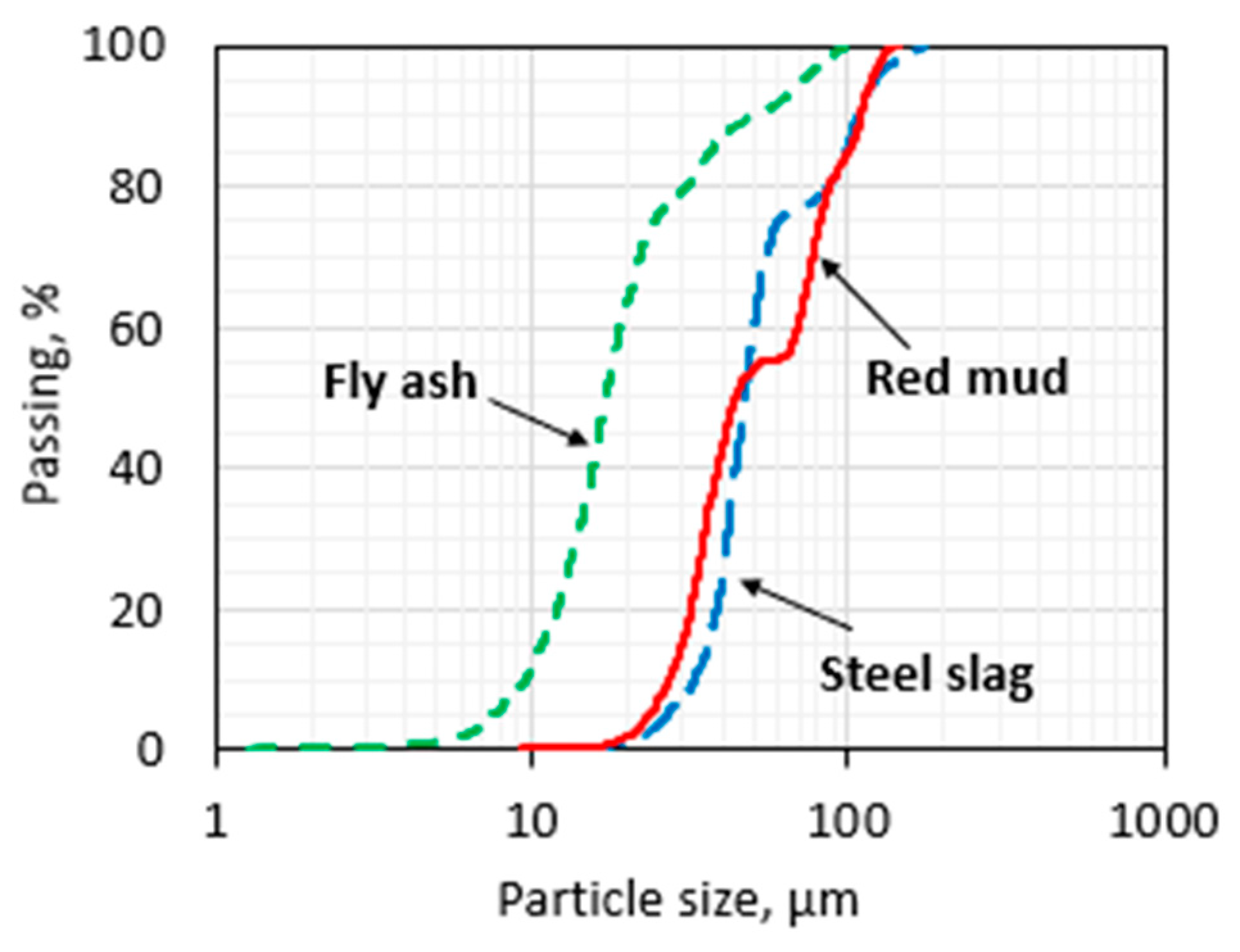

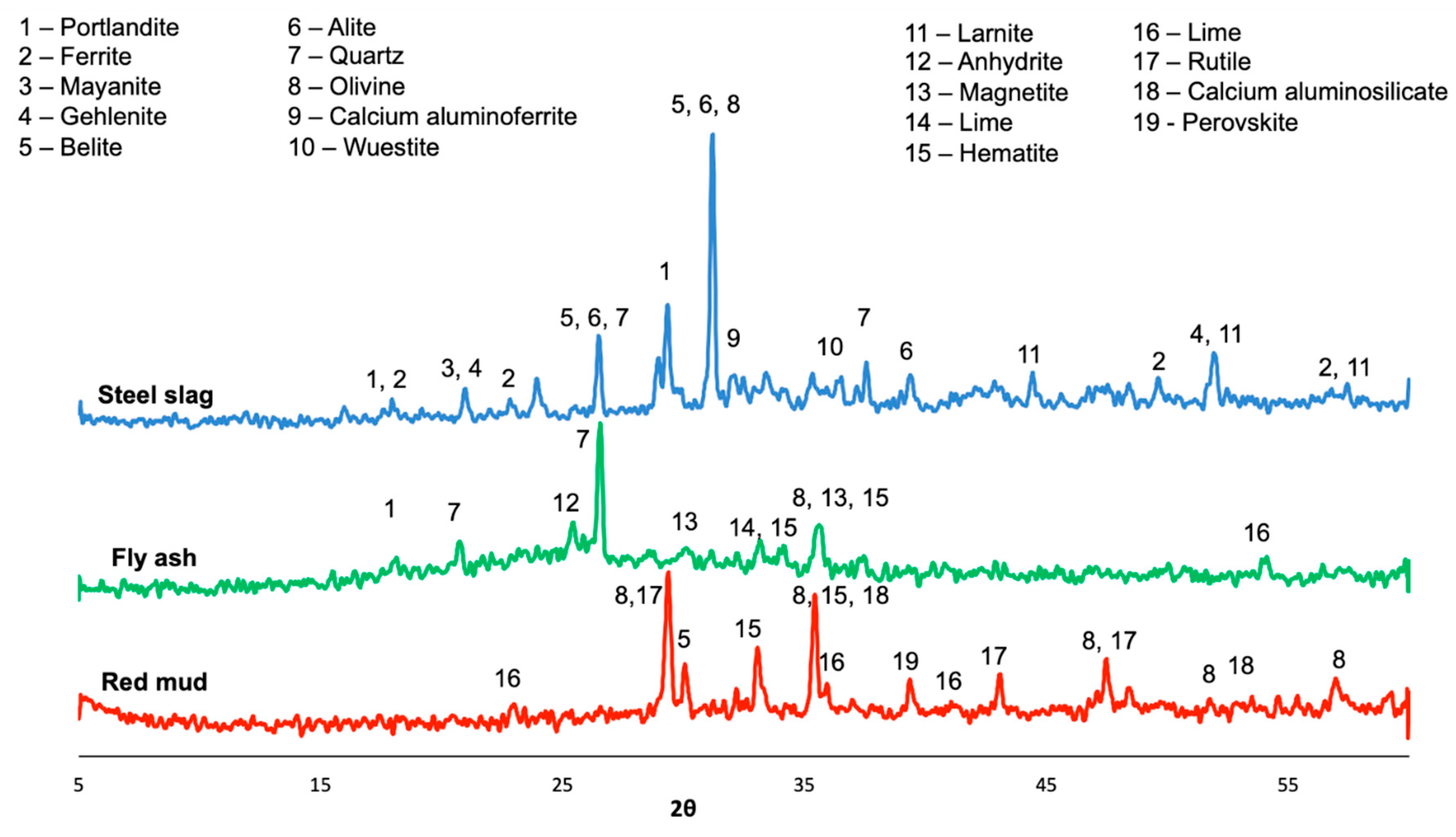

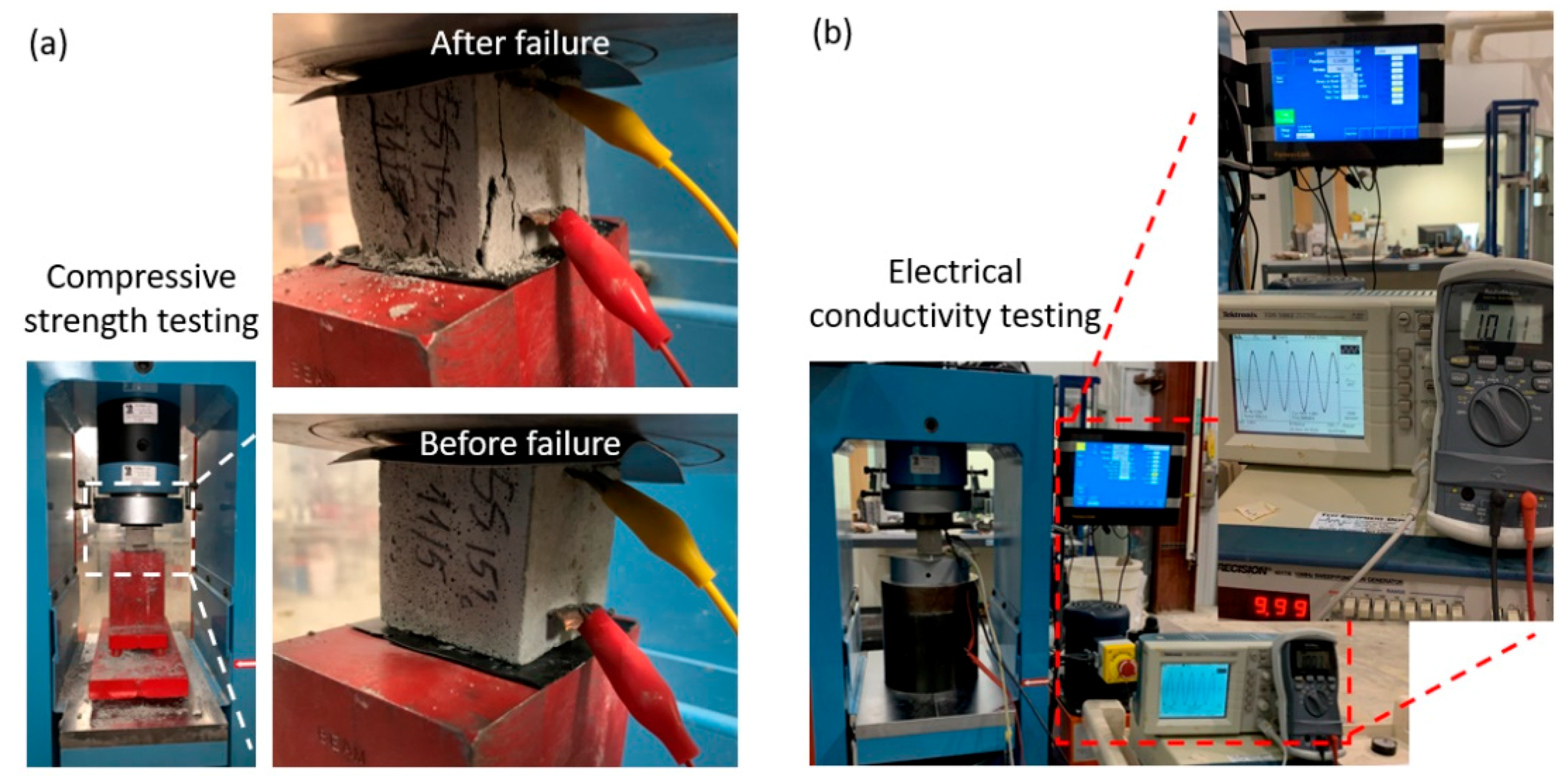

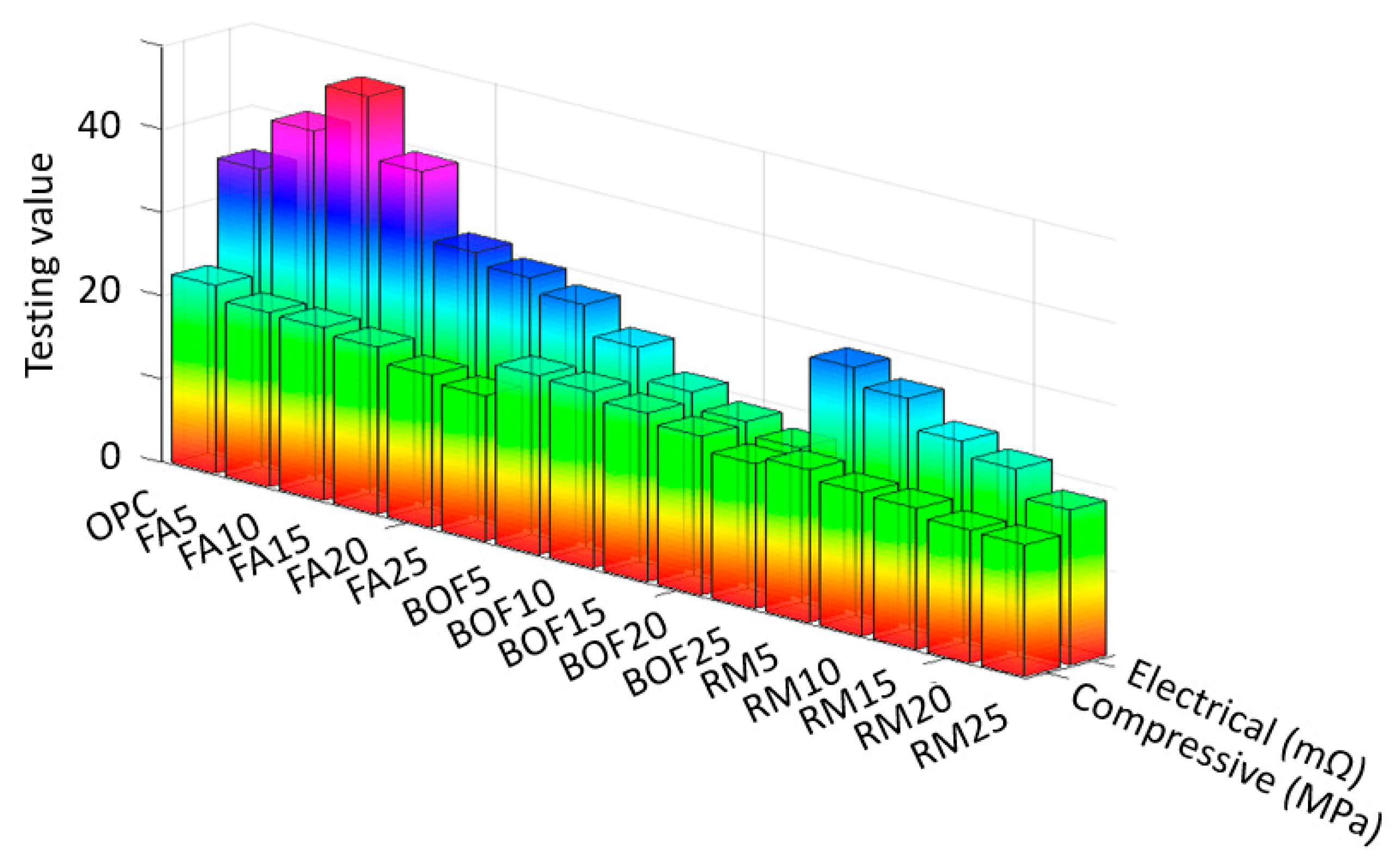

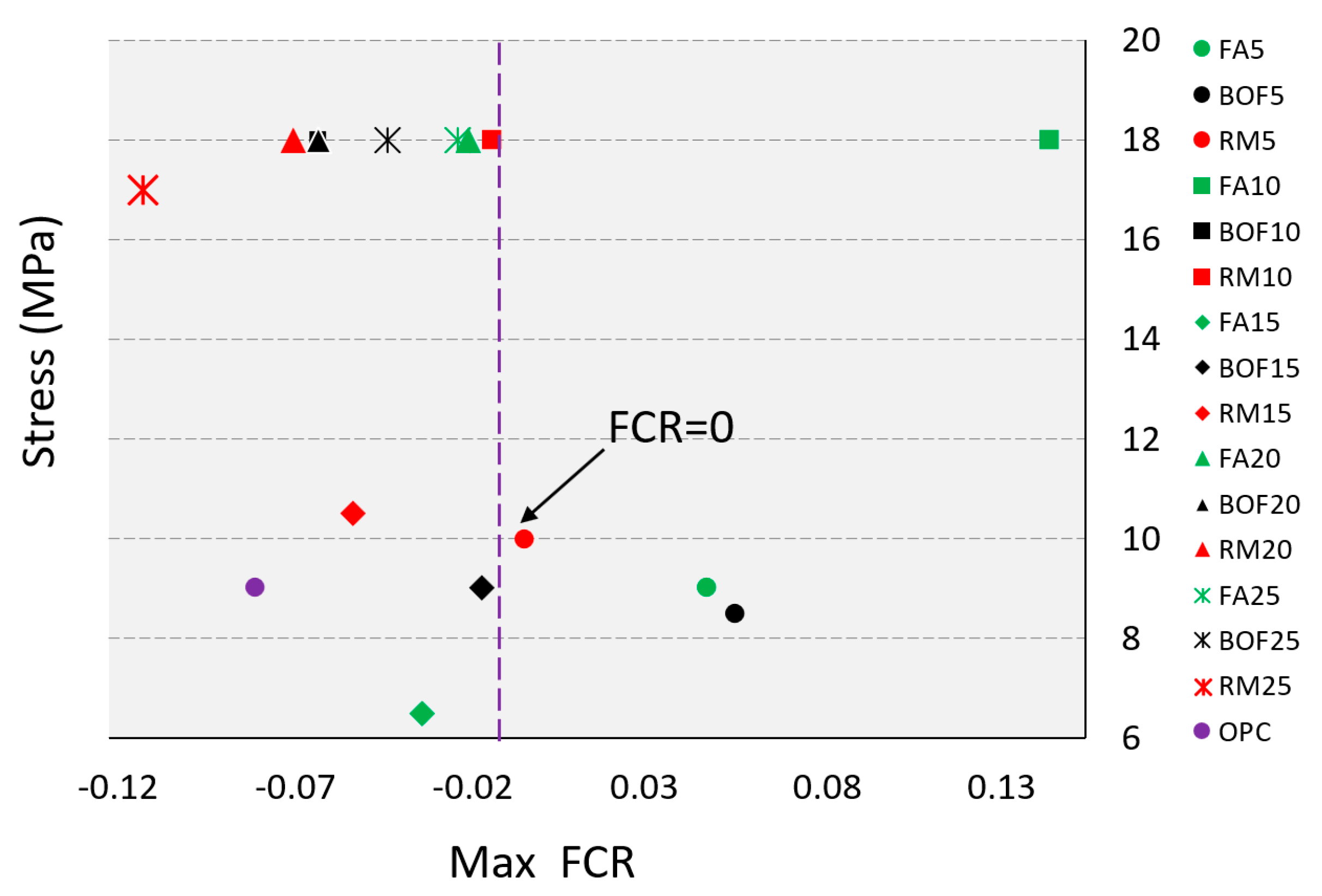
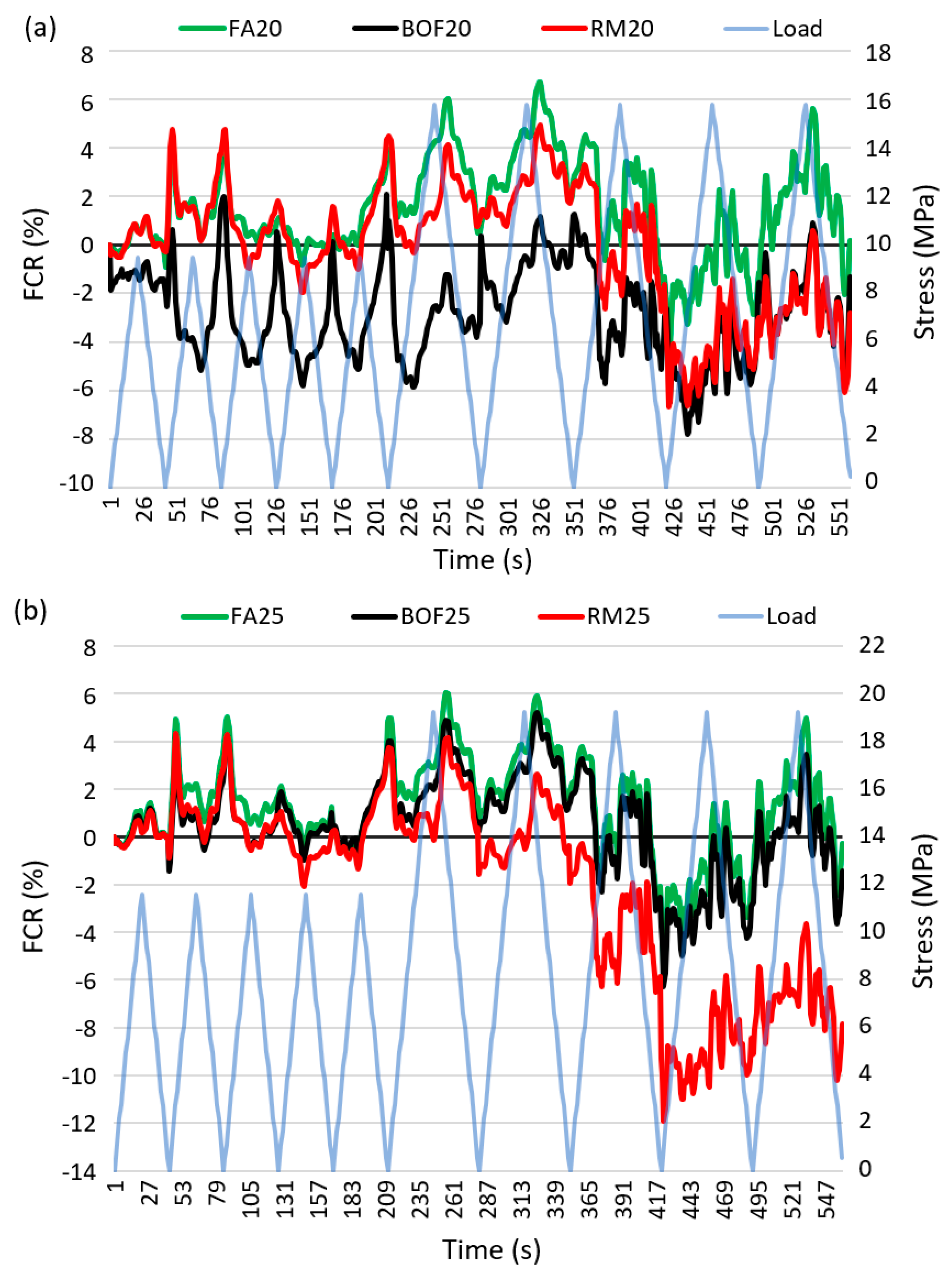
| SiO2 | CaO | Al2O3 | Fe2O3 | MgO | MnO | K2O | Na2O | SO3 | TiO2 | P2O5 | LOI | |
|---|---|---|---|---|---|---|---|---|---|---|---|---|
| Portland cement | 19.2 | 61.7 | 4.7 | 2.3 | 2.6 | - | 1.03 | 0.24 | 3.7 | - | - | 1.3 |
| Coal fly ash (FA) | 36.24 | 10.99 | 23.7 | 9.76 | 2.75 | - | 1.72 | 0.38 | 3.97 | - | - | 3.45 |
| Blast furnace slag (BOF) | 15.6 | 44.7 | 3.9 | 18.4 | 7.2 | 4.4 | - | - | 0.8 | 0.4 | 1.7 | 2.5 |
| Red mud (RM) | 9.6 | 19.3 | 20.7 | 31.8 | 0.3 | - | - | 1.9 | - | 7.3 | 0.8 | 6.15 |
| Additives Type and Fraction (%) | Description | W/C Ratio |
|---|---|---|
| Ordinary Portland cement (OPC) | 100% Portland cement | 0.56 |
| Coal fly ash type F (FA5) | 5% fly ash and 95% Portland cement | 0.56 |
| FA10 | 10% fly ash and 90% Portland cement | 0.56 |
| FA15 | 15% fly ash and 85% Portland cement | 0.53 |
| FA20 | 20% fly ash and 80% Portland cement | 0.53 |
| FA25 | 25% fly ash and 75% Portland cement | 0.50 |
| Blast furnace slag (BOF5) | 5% steel slag and 95% Portland cement | 0.53 |
| BOF10 | 10% steel slag and 90% Portland cement | 0.51 |
| BOF15 | 15% steel slag and 85% Portland cement | 0.50 |
| BOF20 | 20% steel slag and 80% Portland cement | 0.50 |
| BOF25 | 25% steel slag and 75% Portland cement | 0.50 |
| Red mud (RM5) | 5% red mud and 95% Portland cement | 0.53 |
| RM10 | 10% red mud and 90% Portland cement | 0.53 |
| RM15 | 15% red mud and 85% Portland cement | 0.51 |
| RM20 | 20% red mud and 80% Portland cement | 0.51 |
| RM25 | 25% red mud and 75% Portland cement | 0.50 |
| Specimens | Initial Setting Time (min) | Final Setting Time (min) | pH |
|---|---|---|---|
| OPC | 186 | 480 | 12.90 |
| FA5 | 210 | 496 | 12.92 |
| FA10 | 233 | 509 | 12.82 |
| FA15 | 247 | 512 | 12.73 |
| FA20 | 312 | 515 | 12.55 |
| FA25 | 356 | 523 | 12.44 |
| BOF5 | 188 | 451 | 12.68 |
| BOF10 | 195 | 457 | 12.87 |
| BOF15 | 201 | 459 | 12.64 |
| BOF20 | 205 | 462 | 12.55 |
| BOF25 | 217 | 468 | 12.52 |
| RM5 | 173 | 470 | 12.92 |
| RM10 | 168 | 463 | 12.76 |
| RM15 | 165 | 457 | 12.70 |
| RM20 | 157 | 439 | 12.55 |
| RM25 | 150 | 435 | 12.53 |
| Specimen | Stress Sensitivity Coefficient (MPa−1) × 103 |
|---|---|
| OPC | 4.34 |
| FA5 | 6.25 |
| FA10 | 7.17 |
| FA15 | 0.85 |
| FA20 | 8.41 |
| FA25 | 3.13 |
| BOF5 | 1.26 |
| BOF10 | 5.44 |
| BOF15 | 1.25 |
| BOF20 | 5.35 |
| BOF25 | 1.09 |
| RM5 | 3.27 |
| RM10 | 4.18 |
| RM15 | 1.34 |
| RM20 | 2.26 |
| RM25 | 6.29 |
© 2020 by the authors. Licensee MDPI, Basel, Switzerland. This article is an open access article distributed under the terms and conditions of the Creative Commons Attribution (CC BY) license (http://creativecommons.org/licenses/by/4.0/).
Share and Cite
Konkanov, M.; Salem, T.; Jiao, P.; Niyazbekova, R.; Lajnef, N. Environment-Friendly, Self-Sensing Concrete Blended with Byproduct Wastes. Sensors 2020, 20, 1925. https://doi.org/10.3390/s20071925
Konkanov M, Salem T, Jiao P, Niyazbekova R, Lajnef N. Environment-Friendly, Self-Sensing Concrete Blended with Byproduct Wastes. Sensors. 2020; 20(7):1925. https://doi.org/10.3390/s20071925
Chicago/Turabian StyleKonkanov, Marat, Talal Salem, Pengcheng Jiao, Rimma Niyazbekova, and Nizar Lajnef. 2020. "Environment-Friendly, Self-Sensing Concrete Blended with Byproduct Wastes" Sensors 20, no. 7: 1925. https://doi.org/10.3390/s20071925






